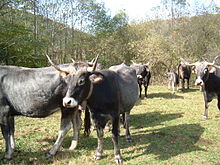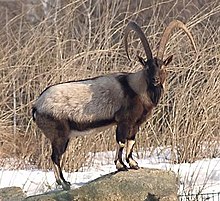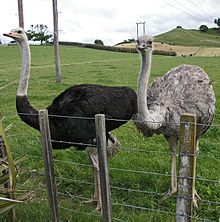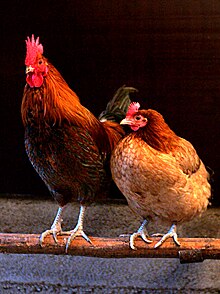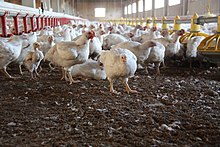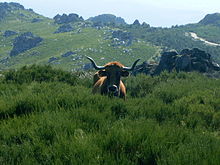Cattle raising
LA livestock or livestock is an activity that consists of the management and exploitation of domesticable animals for production purposes, for their use (some examples include the dairy industry, poultry, fish and pig farming). On the other hand, the management of animals belonging to wild (non-domestic) species in captivity or semi-captivity is known by the name of zoocry.
Depending on the livestock species, various derived products can be obtained, such as meat, milk, eggs, leather, wool and honey, among others. The science in charge of the study of livestock is animal husbandry and the professionals directly in charge of the development of animal production are the farmers, assisted by zootechnicians and animal production engineers, in close collaboration with veterinarians, who are in charge of the prevention and control of animal diseases.
The most important cattle in number worldwide are those related to cattle, sheep and pigs. However, in some regions of the planet other types of livestock are more important, such as goats and horses, as well as rabbit farming, poultry farming and beekeeping.
Livestock is related to agriculture, since on a farm both can be related. In these cases, livestock provide manure, which is used as fertilizer, and crops provide food for the animals.
History
An essential process in the history of societies was the transition from a gathering economy (hunting, gathering and fishing) to an economy of voluntary production of certain plants and animals. In a limited number of places on Earth, certain societies invented the domain of reproduction of species, plants and animals.
To ensure their needs for food, leather, bones, and other products, primitive hunter-gatherer societies had to follow the migrations of large herds of bovids, deer, and other animals. Around 10,000 years ago, Neolithic humans discovered that capturing animals, domesticating them and keeping them alive to use when necessary, allowed them to reduce the uncertainty that, in relation to the possibilities of food, implied by the fact of having to depend on the hunt. The process must have consisted of a period of pre-domestication in which, at first, human beings habituated their prey to their presence while they followed them in their searches for food, to later retain them; This meant that they themselves had to take care of supplying food to the animals. Thus, they managed to domesticate several species, taking charge of moving the herds from some pasture areas to others, emulating their natural movements, but now under their control.
This sedentary lifestyle was linked to the birth of agricultural practices, which linked man to the land and, in addition, allowed the cultivation of fodder for animals. In this way, when man began the domestication of herbivorous animals such as cows, sheep, and goats and abandoned hunting and fruit gathering, livestock farming was born during the Neolithic and, most likely, at the same time as agriculture.
These animals, such as cattle, served, in addition to providing meat, as pack animals for merchandise, plowing, supplying skins and, later, milk and derivatives. The manure accumulated in the stables, stalls and stables must have served as fertilizer for the first crops.
The domestication of animals also allowed them to be used for agricultural work or transporting loads. In addition, the remains of the crops that were not usable for human consumption could be used as livestock feed.
Agriculture and livestock farming allowed human populations to achieve greater certainty regarding their sustenance possibilities, as well as reducing the effort to obtain it, which made possible a greater cultural development, since the human being could then begin to have more time for intellectual creation. In this sense, it seems that the development of livestock farming took place in the Near East, precisely in areas where, in turn, cultural development was more intense and earlier. From these places this new relationship with nature spread, whether the societies that became farmers' and/or herders' societies expanded (largely thanks to the demographic potential that their new mode of production, food and of raw materials allowed), whether neighboring societies, still Paleolithic, have adopted, by their own will or by force, this new way of life.
The term "Neolithization" to designate this process of domestication, derives from "Neolithic" or Polished Stone Age, a word invented by prehistorians of the XIX century to characterize the most recent type, in Europe, of prehistoric industry (stone tool production), just before the Metal Age.
Primary Neolithic sites are rare, each comprising only a small number of species. First, the Fertile Crescent (10,000 years ago) where the pig, goat, donkey and sheep were domesticated. For its part, the cow was domesticated, also 10,000 years ago, in the Middle East and India. In northern China (8,500 years ago), the pig was also domesticated independently; Mesoamerica (8,000 years ago) where the turkey (Meleagris gallopavo) was domesticated, and the Andes, where the llama (Lama glama) began to be domesticated about 6,000 years ago. the alpaca (Vicugna pacos) and the guinea pig (Cavia porcellus).
Meat production began to develop at the end of the XV century, as a precarious production, with scarce resources, scarce marketing and low consumption. Then it was developed on a large scale, generating high profit, and production in excess. During the 19th and 20th centuries, with the European colonization of America, it had an intensive development, which depleted natural resources.
Currently, the extension area of livestock is greater than that of agriculture, since cattle can be raised in areas where the harsh climate makes it impossible to grow crops, such as in the high mountains or areas with extreme aridity. The stabling of cattle and the development of new feeding techniques have contributed to reduce dependence on environmental conditions.
Livestock Species
Different types of livestock are distinguished depending on the species, on the other hand varied, object of exploitation. Thus, in addition to the well-known breeding of cattle, sheep or goats, one can distinguish the breeding of rabbits (cuniculture), that of birds (poultry), etc. Peculiar cases are beekeeping, since it is the extensive breeding of an insect, or vermiculture, which is developed to obtain mulch. At present there are even farms dedicated to raising crickets for use in feeding pet animals as peculiar as reptiles. Other cattle ranches are those developed for the fur industry, its greatest exponent being mink breeding.
According to the species domesticated or bred, cattle are classified as:
- cattle or cattle: It is the set of cows, bulls and oxen (different types of cows). By extension it is known simply as livestock proper.
- Earned sheep: It is a set of sheep and lambs
- Porcine Winner: It is a set of pigs
- Goat win: It is a set of goats
- Earrings: It is a set of horses and mares
- Poultry: It is the breeding of poultry to take advantage of both its meat and its eggs.
- Abyss: It is bee breeding
- Aquaculture: It is fish breeding
- Heliciculture: It is snail breeding.
- Cunculture: It is rabbit breeding.
- Sericculture: It is the breeding of the silkworm
Cattle
The domestic bovine descends from a group of breeds of aurochs, Bos taurus primigenius, now extinct. Aurochs, of which the last specimen died in a Polish park in 1627, were once very common in Europe, their range extending through North Africa and the Middle East to Southeast Asia and China. 2 main types of domestic cattle, the taurines (Bos primigenius taurus) which have no hump, and the zebu (Bos primigenius indicus) which have long skin folds and a marked hump at the level of the shoulders; the latter are the most popular in the intertropical zone and other hot regions.
The 2 types, due to their total interfertility, are usually considered as subspecies. In addition, it has been verified at the molecular level that all European and African breeds of domestic bovines, whether of Zebu or taurine origin, are from the same mitochondrial line, while the Indian breeds are from another. Similar studies using Y-chromosome DNA show the zebu ancestry of African horned bovine populations. The interpretation of these results is that the African Zebu have developed from a hybrid origin, the introduction of Zebu blood being mainly done through the males. There is then some evidence of two separate domestications, undoubtedly of two different subspecies of aurochs.
Cattle are raised all over the world for their working capacity, their meat, their milk, and their leather. They are also still used in bullfighting in some countries. The female is the cow and the male, the bull (if it has been castrated it is called an ox). The young of the cow are the calves or calves and the young specimens are known as yearlings when they are one year old, erales when they are more than one year old and less than two years old, and steers until adulthood (animals over two years old). years and less than three are also called utreros, and cuatreños when they are four). The breeding and use of these animals by man is known as bovine farming. The United States is the country where most of the meat and milk production is located. This country has a great difference with its escorts, among which are Brazil, China, India, Argentina and Australia in meat production, and India, Russia, Germany and France in dairy production. There are hundreds of breeds in all over the world with particular characteristics that make them more suitable for a particular use or more adapted to be raised in certain regions.
Sheep and goats
Goats (Capra aegagrus hircus), together with sheep (Ovis orientalis aries), were one of the first species to be domesticated. There are remains of goats in archaeological sites distributed throughout the Fertile Crescent, which allows us to date the domestication of both between 6,000 and 7,000 years BC. C. and makes them the first domesticated grazing animal in the world (Zohary, Tchernov and Kolska Horwitz, 1998, p. 130). The ancestor of the sheep is considered the West Asian mouflon (Ovis orientalis), which is the only congener of the sheep in that area with which it can produce fertile individuals, since they have the same chromosome number (2n=54). In the case of the goat, the main ancestor of modern breeds is considered to be the bezoar goat (Capra aegagrus aegagrus ) which is distributed from the mountains of Asia Minor through the Middle East to Sindh (Zohary, Tchernov and Kolska Horwitz, 1998, p. 130). Unlike the sheep, however, the goat reverts to the wild or feral condition easily if given the chance. There are currently dozens of breeds of goats around the world.
In the case of sheep, the female is called a sheep and the male is called a ram (which generally has large horns, usually long and spiral). The young of the sheep are the lambs and the young specimens are known as rams. A group of sheep make up a herd, herd or flock (Argentina), and the fence where they go is called a fold, brete, fold or corral. The breeding and use of these animals by man is known as sheep farming. In goats, the female is called goat, the male is called cabro, chivato, male goat, castrón or cabrón, and the young are called goat, goat or chivito.
Sheep and goats are used for their meat; its milk, with which cheeses are made, standing out those of goat; the skin, and the wool and other hair fibers of the animal; their droppings are also used as fertilizer. China is the main producer of meat and wool from these animals, followed by New Zealand and Spain. Turkey and Syria stand out in the production of sheep's milk, while India, Bangladesh and Sudan do it in goat's.
Pigs
The wild ancestor of most domestic pig breeds is the wild boar (Sus scrofa). It is considered to have been domesticated independently in several geographically and temporally widely separated locations, using different founding bases from the start depending on the local subspecies and breeds. The Sulawesi wild pig (Sus celebensis) has been domesticated on the island of Sulawesi, probably at the beginning of the Holocene.
Pig cattle are used for their meat; its fat, which is edible; its skin, for the elaboration of leather, and the bristles, for the manufacture of brushes, among other products. China is the main producer in the world, with a wide difference with its escorts, among which the United States, Germany, Spain and France stand out.
Birds
Chickens, ducks, geese, guinea fowl, quail, pigeons and turkeys help meet the protein needs of the world's poorest and contribute significantly to the diets of the developed world through the poultry industry. These birds are often free-range, meaning they find food on their own, at lower cost, in areas where cattle cannot survive, such as those infested with the tsetse fly (Glossina spp..). Ostriches, emus, rheas, and cassowaries are to varying degrees of domestication for their fur, meat, or other production.
The red jungle fowl and its close relatives in the genus Gallus are the ancestors of the domestic fowl (G. domesticus). Many duck species are easily adapted to captivity and several tropical wild species appear to have good potential for semi-domestication in the Third World countries from which they originate. The wild mallard (Anas platyrhyncos), a widespread species, is the ancestor of modern domestic duck breeds. Domestic ducks are of great importance as a food source in Asia, especially in the Southeast. Their eggs are the most important there, while to the north the production of meat takes on greater significance. By contrast, ducks are currently of minor importance in Africa, Latin America, and the Near East.
Today's domestic geese are all descended from two species: the western European breeds of the moose goose (Anser anser) and the Asian breeds of the stork goose (Anser cygnoides). These two wild relatives of the domestic geese are native to the temperate zones of the Northern Hemisphere. The gray goose, the southernmost of the "grey geese" that breed in Europe, has been preserved by man since Neolithic times. It is the ancestor of most of the European breeds of geese. The swan goose is native to China and Mongolia. Although it was domesticated under the name of "Chinese goose" for about 3000 years, in the wild it remains one of the least studied subarctic waterfowl species. Unlike chickens, geese have the great advantage of being able to be raised solely on protein provided by grass. Geese have a tendency to eat more than they need, a tendency that has long been exploited both for fattening and for making them too heavy to fly. Since tame geese breed freely with wild individuals when found, domestication has not resulted in the creation of identified breeds.
The domestic guinea fowl (Numida meleagris) descends from only one of the seven wild subspecies: Numida meleagris galeata). The guinea fowls were domesticated in Egypt and Greece approximately in the years 1745 a. C. and 400 a. C., respectively.
Indigenous domestic turkeys of Latin America were domesticated from Meleagris gallopavo gallopavo, the wild species from Mexico. These have spread to Central and South America and subsist as "indigenous" domestic turkeys. Its plumage is mostly black. Some turkeys from Latin America were brought to Europe in the 16th century and later to North America in the 18th and 19th centuries. There they crossed with another wild subspecies, Meleagris gallopavo sylvestris, to give rise to the bronze turkey, the forerunner of all commercial turkeys in developed countries.
Huge walking birds and the largest living today, the ostrich (Struthio camelus) is currently endemic only to Africa, but in other times it was widespread as far as the Arabian peninsula from where it disappeared around 1968 The ostrich is currently widespread throughout eastern and central Africa, from south of the Sahara to the Cape Province. It is also found in southern Morocco, northern Sudan and southern Egypt. Ostriches reproduce without problems in captivity, when they are well fed and maintained. Domestication, which began in Algeria around 1860, has been ongoing in South Africa for more than 100 years. Ostrich skins are processed in South Africa and Germany and are used in the manufacture of women's handbags, shoes and briefcases in France and Italy. The greatest demand for these items comes from Japan. Almost nothing produced by the ostrich is discarded. There is a good market for their feathers and down, the meat is sold for human consumption (fresh or dried) and also, with the bone and dried and sterilized, it is used as a complementary food in the ostriches' diet. Even the shells of the eggs can be used to make necklaces and bracelets. The most valuable product, however, is the skin, which is obtained at 14 months of age.
Rheas (Rhea americana) are large walking birds of South America. Throughout its area of expansion, the species has always been exploited for its meat, its eggs, its feathers, its skin and its oil with various applications in aboriginal and Creole cultures. In Argentina, the skin of the rhea is used to make leather goods and the feathers are used to make feather dusters. The meat, especially that of the thighs called "picana", is eaten locally along the Argentine coast and in southern Brazil. Eggs are also eaten.
The meat and eggs are mainly obtained from poultry, although in some species their skin and feathers are extracted. The most prominent producers are the United States and China, while in the European Union France, the United Kingdom, Italy and Spain stand out.
Donkeys
Until Roman times, three savage races appear to have existed. One of them, Equus asinus asinus, from which the domestic donkey probably derives, existed in northwest Africa and disappeared from the wild in Roman times. A second type of wild asses lived in the mountainous deserts of Nubia and eastern Sudan, between the Nile and the Red Sea. This subspecies, E. africanus africanus, which contributed equally to the creation of the domestic donkey, is now presumed to have disappeared from the wild. The third species, and the only one surviving, is the Somali wild ass, E. africanus somalicus.
Civets
The African civet (Civettictis civetta) has been bred in captivity in Ethiopia for several centuries. Civet musk, a foul-smelling product of the male's anal glands, has marked fragrance-fixative power and is used in the manufacture of expensive perfumes. The farms are mostly located in the lower western mountains and in the Sidamo region. The civets are fed with a mixture of fruits, vegetables, cornmeal and meat. Ethiopia has a virtual monopoly on musk production worldwide, exporting around 2,000 kg each year. The small Indian civet (Viverricula indica) is bred in India and Thailand. The musk is exported to China for the pharmaceutical industry. Thai civet hatcheries are run in partnership with chicken hatcheries and civets are fed boiled eggs with dead chickens inside. Small civets are also reared in cages in many homes in the State of Kerala, in southern India, for the recovery of the musk that is produced by the anal glands. Musk and the ketone compound "civetone" they are sold to Ayurvedic doctors for medicinal use.
Rabbit
It is now thought that the ancestral form of the domestic rabbit was Oryctolagus cuniculus huxleyi, which exists only in Spain and Portugal as well as on some Mediterranean islands. All other wild rabbits in Europe belong to the typical subspecies and would have descended from semi-domestic rabbits introduced by the Romans, who were very fond of eating the fetuses and newborn rabbits which they called 'laurines'. In this sense, O.c. cuniculus should certainly be considered as returned to the wild. The differentiation between the two subspecies is confirmed by morphometric and DNA studies. The monks of the Middle Ages were in the habit of eating "laurines" during Lent, since these animals were classified within the "aquatic dishes". The controlled breeding of the rabbit, as well as its domestication, began in the 16th century and was probably mainly due to the work of the monks. As a result of the Crisis in Venezuela, in 2017, the government of Nicolás Maduro promoted the Rabbit Plan, to raise domestic rabbits for human consumption, in order to face food shortages.
Elephant
Domesticated for thousands of years, the Asian elephant (Elephas maximus) is always very useful for the timber industry in many Asian countries where it allows selective cutting rather than hitting blanks. Selective cutting is a much more sustainable way of exploiting forests and is much less harmful to the environment. The economic and environmental advantages of using the elephant in logging are numerous. Trained elephants are good for the environment and for the user. Its use avoids drawing expensive routes in the woods, essential for the passage of heavy machines. Elephants can work in difficult, rugged terrain where no machine can go. Unlike machines, the elephant does not rust, corrode or pollute the environment. They do not need expensive spare parts and their waste serves both as fertilizer and as a means of disseminating grains in the jungle. The use of elephants for clearing greatly reduces the damage to the environment caused by heavy machinery and for this reason erosion and soil compaction are reduced. Asian elephants are increasingly used as viewing platforms for tourists in national parks and become an essential element of many eco-tourism ventures.
Other pets
Other domestic animals are horses, mules, dogs and cats; camelids such as the Bactrian camel, dromedary, llamas, alpaca and vicuña; not forgetting the water buffalo and reindeer.
Classification of the livestock industry
The cattle industry classifies cattle as the target:
- Winning breeding foot
- Gained fattening
- Milk earned
- Double purpose win
- Extensive livestock
- Intensive livestock
Forms of exploitation
Intensive farming
In intensive livestock farming, the cattle are stabled, generally under conditions of temperature, light and humidity that have been artificially created, with the aim of increasing production in the shortest period of time; the animals are fed mainly on fortified feeds. This is why it requires large investments in aspects of facilities, technology, labor and food, among others.
Among its advantages, high productivity stands out, which has as a counterpart the great pollution it generates.
Intensive farming is practiced primarily in the central and western United States, in Canada, and in Western Europe and China. Over the years, farms have been installed in the vicinity of the cities, which are highly industrialized. They mainly raise pigs, birds and rabbits, with the aim of supplying the cities with their meat.
It is the application of multiple technologies and the forms of thought that emerged from capitalism, which were born with the Industrial Revolution, to livestock. This application occurred in the XX century and in Spain from the 1960s. The principles of intensive farming are the to obtain the maximum benefit, in the shortest possible time, concentrating the means of production and mechanising and rationalizing the processes, to constantly increase the productive performance.
The example of intensive farming is poultry farming, in which there is an artificial selection of chickens, either for the production of eggs or meat. These birds are raised in huge sheds that are not always conditioned, with the animals crowded into batteries, in an environment regulated in terms of temperature, light and humidity, mechanized to the maximum, where water and feed enter on one side and eggs and droppings come out on the other. (faeces). Intensive farming is therefore governed by the laws of industrial production.
Advantages of intensive farming
- Efficiency: Intensive cattle breeding obtains maximum production per unit of time and by animal breeding.
- Market demand adaptation: Adjusted to consumer demand.
- Homogeneity: it is obtaining homogeneous products or of equal characteristics, to meet the needs of large-scale distribution and marketing.
Disadvantages of intensive farming
- Great energy consumption, usually of fossil energy origin, sometimes up to 20 kilos per kilos in the obtained food.
- Extremely polluting, due to the accumulation of huge masses of injections, which cannot be recycled in conventional agrosystems and which cause air pollution, soil and water pollution with nitrogen, phosphates (eutrofization) and heavy metals (copper), drugs, etc.
- Ephemeral: Intensive cattle breeding is not lasting, that is, it is "unsustainable", which implies that it cannot be kept indefinitely in time, because it is a linear production and not being based on the recycling of the nutrients within the territorial basis of the exploitation and use of the energy fixed in it.
- It requires a high concentration of capital and a high level of control of production cycles.
Extensive livestock farming
Extensive livestock farming is that which makes efficient use of the natural resources of the territory, with a low use of external inputs and mainly through grazing.
In general, it is characterized by the use of livestock species and breeds adapted to the territory, the use of diverse pastures adjusting to their spatial and temporal availability, and respect for the environment in which it is sustained. Indeed, extensive systems are mainly based on grazing natural ecosystems modified by man, configuring agroecosystems and are subject to natural cycles.
Within extensive livestock we could include sustainable or ecological livestock, which is livestock that lasts over time and maintains a level of production without harming the environment or ecosystem. Sustainable livestock farming is included within the concept of sustainable development. In any case, both extensive and intensive livestock have impacts on the environment and climate change.
Generally, extensive cattle farms take advantage of all types of pasture: meadows, pastures, herbs and stubble; own, others or communal, permanently or temporarily. This economic activity is essential for the territory and society, since it not only generates quality products, but also configures landscapes, helps control forest fires, regulates water cycles and soil quality, helps enhance biodiversity and preserve cultural heritage and territorial identity.
Advantages of extensive livestock farming
- They require a small supply of fossil energy, sometimes it takes 0.1 kilos or less to get 1 kilos of food at the consumer table. Increased global energy efficiency.
- They contribute to maintaining the agroecosystems of which they form an essential part, maintaining the natural agroecosystems of the environment, such as biodiversity.
- Forest fires are prevented by arbusive control, reduction of biomass fuel, etc.
- They take advantage of natural pastures that only through pasture and extensive livestock can be transformed into food for the human being.
- Lower dependence on agricultural products such as cereals, soy, etc.
- It dynamizes the rural economy and fixes its population.
- It provides greater well-being to animals.
Disadvantages of extensive livestock farming
- Lower control of the environment in which animals are unfolded and dependent on climate cycles.
- Lower productivity per surface unit.
- It cannot be easily adjusted to consumer demand.
- It cannot provide products as homogeneous as it requests the distribution and market of large commercial surfaces.
Transhumant livestock
Transhumance is defined as a type of livestock that is mobile, adapting in space to areas of changing productivity. It differs from nomadism, in that the grazing places in each season are fixed. It is estimated that this activity, added to that of nomadic livestock, employs about 100-200 million people in the world; the land exploited under these systems represents approximately 30 million km², double the land dedicated to agriculture.
This type of livestock has great advantages, such as increased soil fertility, which benefits from the addition of manure and other vegetables. In Spain, for example, many forests have been preserved thanks to the passage of cattle, such as the pine forests in Guadarrama and in the Serranía de Cuenca; the beech and oak groves on the Cantabrian coast and the holm and cork oak groves in Andalusia and Extremadura. Animals also contribute to fighting fires, since they have highly combustible materials for food.
Since the XII century, there has been a law in Spain that protects some 125,000 kilometers of livestock roads, which is equivalent to some 400,000 hectares. These roads allow the movement of herds throughout the country under a transhumance regime.
Nomadic herding
Nomadic herding is, even today, the way of subsistence for various peoples who are marginalized, such as the Tuareg, who live in the Sahara desert; the Maasai, who occupy the mountainous areas of Kenya and Tanzania; and the Lapps, also called Saamis, who are found in the north of the Scandinavian Peninsula and Russia. Currently, the future of these human groups and their economic activity is threatened by regulations that prohibit the free movement of cattle and occupy nomadic territories for agricultural, industrial and urban purposes.
Egg production
Its purpose is the production of commercial eggs for consumption, either white (those produced by Leghorn breed hens) or colored (those obtained from brown hens, based on the New Hampshire and Rhode Island Red breeds, for the general). Not wanting fertilized eggs, these hens are without roosters. Typically, this intensive production is based on large battery systems, where the hens are confined to a small space. The eggs have two destinations according to the sex of the chick: if it is female, it grows in captivity and when it grows, its beaks are cut to prevent them from hurting each other (due to the reduced space in which they live) and, if it is male, it is they send to the slaughterhouse or to the crusher, since they do not lay eggs and do not generate profit. This system, used almost everywhere in the world, is being modified in some countries, especially in the European Union, due to pressure exerted by environmental groups. The productive alternative modification is raising the hens on litter and/or going out into the field. With this, eggs identical to the "industrial" ones are obtained, but they satisfy consumers who are looking for more "natural" products, despite the inconvenience of being more costly.
Meat production
Its purpose is the training of animals that have an appropriate quantity and quality of muscle tissue at the time of slaughter, which is known as meat; These requirements must be in accordance with the market that will consume the product. In production there are two stages, breeding and fattening.
The breeding stage has as main objective the generation of calves, obtaining weaned calves. Instead, the fattening stage is carried out to bring the animals to the best possible conditions for slaughter. If the animals obtain their food through grazing and in the open field, the process is called wintering, while if it is done in corrals and the food is balanced, it is called feedlot. The final product of both processes is a steer that reaches the degree of completion (that is, the deposition of fatty tissue) that the market to which it is directed demands and is commonly called "fat", that is, in conditions to be slaughtered.
Environmental impact
The environmental impact of livestock varies due to the diversity of forms of agriculture used in the world. Like almost all human activities, cattle ranching has environmental impacts, some positive and others negative.
Globally, livestock occupies 70 per cent of all land used in agriculture, or 30 per cent of the Earth's ice-free land. Eighteen per cent of anthropogenic greenhouse gases could be due to livestock emissions and related activities, such as deforestation to establish grasslands, soil erosion or over-storage and increased intensive fuel consumption practices. Specific terms of reference for the livestock sector include: 9% of global CO emissionsTwo. 35-40% of global emissions of methane (mainly due to interica fermentations and dung) and 64% of global emissions of nitrous oxide, mainly due to the use of fertilizer. Access roads also facilitate the destruction of the habitat and its conversion to form potters. This problem is particularly serious in cattle farms that are implemented in the tropical rainforest of Latin America, such as the Amazon basin, and is not sustainable in the short term.
Another problem is desertization. The cattle farms that are established in natural grasslands usually require constant control of their ability to prevent overgrazing during dry years. Domestic livestock must inevitably take water every day; therefore it is difficult to avoid overgrazing around water sources. So, the potential of the use of wild cattle should be studied during the preparation of the project, because it does not require water every day, it does not suffer the bite of the tsesé flies, nor the insects, as it happens with cattle; consequently, there is no need for insecticide; they eat a wider variety of vegetation and also mordisquean, so they can give more products, in the medium and long term, than cattle bovine.
Other problems are excess pesticides and the processing of the affluents of slaughterhouses. For the environmental impacts of meat processing and other livestock products, see Environmental Impact.
The aim of cattle breeding is to improve the conditions and productivity of grazing land, the health and productivity of livestock (including cattle, sheep, goats, buffaloes, oxen and pigs) for meat, milk, skin, and fiber and the well-being of herders. The grazing land includes pastures, the open forest (and in some places the broken areas of the closed forests), the bushes, and the deserts that sustain the domestic ruminants and wild herbivores. There are projects that contemplate other uses of grazing land, such as the conservation of fauna, the capture of water, tourism, recreation, hunting, and mining and oil.Contenido relacionado
Hominidae
Poliomyelitis
Trigynaea

